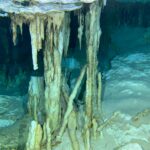PME’s miniDOT logger is a compact, completely submersible device used to monitor dissolved oxygen and temperature. Fully functional in fresh- or saltwater environments, the miniDOT measures dissolved oxygen through a fluorescence method. Data are recorded to an internal SD card. Operational details such as setting the time and sample interval can be accomplished through the USB cable.

Studying the Environmental Parameters and Fauna of Underwater Caves
December 2, 2019
miniDOT Logger Compares Nutrient Utilization and Cycles of Lakes
August 12, 2020Water Column Investigation at Kauai Sea Farm
Project Details
- PRODUCT(S): miniDOT® Logger
- APPLICATION: Coastal / Ocean
- PARAMETER: Dissolved Oxygen, Temperature
- LOCATION: Kauai, Hawaii
- ORGANIZATION: Kauai Sea Farm
- RECOGNITION: Dave Anderson, Production Manager
Case Study Description
Nestled in the caldera of a dormant volcano in Kauai, Hawaii, Kauai Sea Farm uses this natural feature for their base of operations to raise both clams and oysters. Though fresh sea water moves in and out of their pond throughout the day, the pond was stratified based on temperature. Knowing that this can affect dissolved oxygen (DO) saturation which impacts the health of the aquatic life, they deployed a miniDOT logger to investigate further.
Finding a Sweet Spot
Clams and oysters spend most of their lives in a stationary position, which makes finding the perfect spot for them in a pond very important. Two major variables dictate this placement: DO saturation and food abundance. Optimum food sources are located along the bottom of the pond, which can be as deep as 30 feet. However, the deeper you go, the less DO is available for the sedentary crop.
Finding that sweet spot of DO and food source is key to consistently raising a quality crop. Anderson and his team tied the miniDOT logger to the end of a rope with knots marking every three feet, lowered the miniDOT to the desired depth, and connected the end to a buoy. Repeating this strategy at different locations and depths every two weeks in the pond has allowed Kauai Sea Farm to determine the optimal location and depth to raise clams and oysters, which will result in bringing the crop to market more quickly and increasing profits.
A few weeks ago, Anderson took time to talk with PME CEO, Kristin Elliott, about the farm.
Conclusion
With the help of the miniDOT and ensuing data interpretation, Kauai Sea Farm has been able to pinpoint areas within their pond that are the most optimal for raising clams and oysters. This knowledge will allow them to decrease the chances of loss and increase production in those areas that are abundant in both DO and food.

